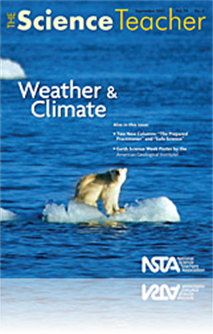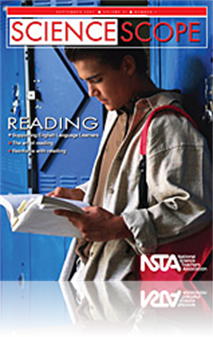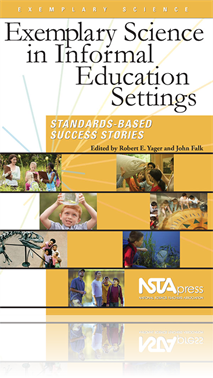All Resources
Journal Article
The Tree of Animal Life activity is a simple, sorting exercise that can help them see a bigger picture. The activity sets the stage for learning about animal taxonomy and introduces the characteristics of various animal groups in a general way. Thoug...
Journal Article
Students can gain an appreciation for the structure and function of local environments by studying the potential impacts of small changes in local microclimate on plant distribution. The concept of microclimate is easy for students to comprehend, sim...
Journal Article
Science Sampler: Using the arts to enhance science learning
Over the years, the author has developed several lessons in which songs, arts and crafts, drama, and body motions are used to better facilitate student learning in life science. This article presents a sample of songs that correspond with a study of ...
Journal Article
Teacher’s Toolkit: Methods for success as a middle school science teacher
Effective teachers are prepared with methods for teaching science. Without them, the first day of school will be a disaster that will likely continue throughout the year. This article outlines some methods that will ensure success in teaching middle ...
Journal Article
Tech Trek: Electronic bulletin boards and digital student groups
Nothing is as irksome as a student who returns from a couple of days of being absent and asks nonchalantly, “Did I miss anything?” Not only do you have to backtrack through what you did in the last few days of instruction, but you must also remem...
Book Chapter
Science with Attitude: An Informal Science Education Experience
Kansas City's Science City Summer Camp is an eight-week program for children of ages 6-12 from a variety of socioeconomic backgrounds. Drawing on the knowledge that people have diverse learning styles, Science City introduces science concepts each da...
Journal Article
Editor's Note: Animals and the Capacity to Care (September 2007)
While the study of animals can serve to motivate, it can also present difficulties. Some animals are just too hard to study through inquiry. The animals may be too large or small, too distant, or too dangerous to bring into the classroom. Technology ...
Journal Article
Teaching through Trade Books: The Dirt on Soil
Have you ever played in the dirt? Repotted a plant? Planted a garden? In each and every one of these activities, you touched something that is a valuable resource in our lives—dirt! This month’s column has students investigating different aspects...
Journal Article
Science Sampler: Did the beanstalk really reach the sky? Using fairy tales to teach science
Inquiry is the guiding philosophy in school science curriculum design in Singapore. Inquiry requires students to be able to use their existing scientific knowledge to formulate hypotheses and critique and evaluate things they observe around them. Thi...
Journal Article
Idea Bank: Thinking Like Scientists
Students often find it challenging to adopt the mindset needed in inquiry-based science classes—that is, to think and act like scientists and use the processes of science. To familiarize students with this mindset, begin the school year with the ac...
NSTA Press Book
NSTA Guide to Planning School Science Facilities, Second Edition
Science-learning spaces are different from general-purpose classrooms. So if your school is planning to build or renovate, you need the fully updated NSTA Guide to Planning School Science Facilities. It’s the definitive resource for every K-12 scho...
By LaMoine L. Motz , James T. Biehle, Sandra S. West
Journal Article
Formative Assessment: Redirecting the Plan
The science teachers at New Hampshire’s Concord High School are no longer satisfied with what Wiggins and McTighe call the “teach, test, and hope for the best” learning cycle (2005). These teachers have been stepping up to the professional resp...






